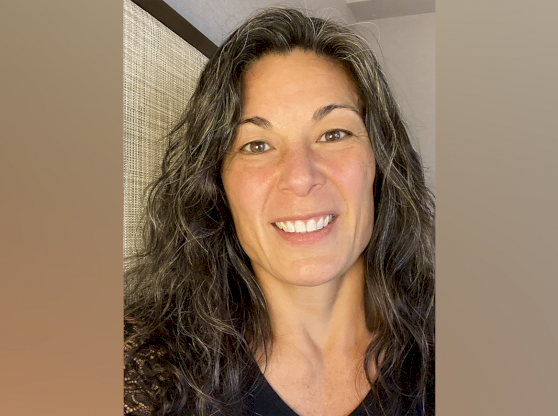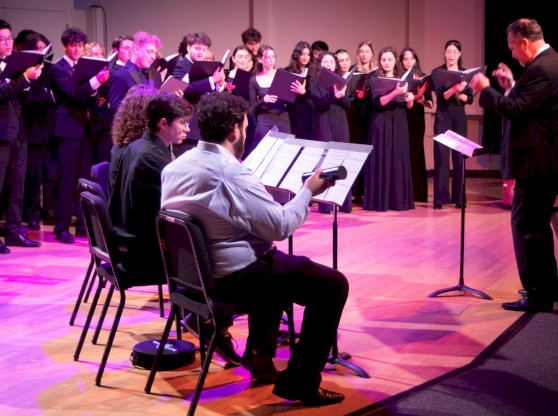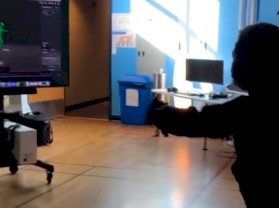Over the past year, UF College of the Arts students Sarah Albee (BFA, Dance, 2024) and Brendan Sweeney (PhD, Music Composition, 2025) have collaborated on a series of projects that pair Sweeney’s musical compositions with Albee’s choreography and dance.
On Nov. 18, 2023, Albee and Sweeney staged their most recent collaboration at The Harn Museum of Art in SOUNDS MOVES: MUSIC & DANCE, in which graduate composers from the School of Music team up with undergraduate students from the School of Theatre and Dance to premiere works in collaboration with New York-based BlackBox Ensemble. These performances are conceptually inspired by works of art on display in the Metamorphosis: Reshaping Contemporary Art exhibition, as interpreted by the composer and choreographer.
For this collaboration, Sweeney and Albee composed and choreographed a piece inspired by “Pattern Kinship, Bubbles, ping-pong” (2022), a painted aluminum sculpture by Turkish artist, Nevin Aladağ.
Following the performance, Sweeney and Albee sat down with UF College of the Arts In the Loop News to discuss what it’s like working together in overlapping disciplines.
This interview has been edited for length and clarity.
In the Loop: Hey, Brendan and Sarah! Thanks for taking the time to speak with The Loop. Can you tell us a little about the process? How long have you been collaborating? And how did you end up working together?
Brendan Sweeney: So, for this specific piece, the graduate composers organize a residency annually with Joan Frosch, [co-founder of the Harn Museum of Dance program]. Sarah was assigned to the piece, I think, only a few weeks ago.
Sarah Albee: Yeah, around three weeks ago—maybe not even that.
Sweeney: I finished the music at the end of August, and no one really knew what it sounded like—so, the process requires a lot of trust. It's a lot of knowing that Sarah and I are in the same place, conceptually. We talked about what we liked about the work, what the work brought out in us, and then we developed the music separate from the improv score.
Albee: It was interesting, because obviously Brendan has his own ideas about how the piece influences the music. But for me, I have to take that and make it physical; make a dance. So, making sure that we’re on the same page about the music and the dance conceptually working together is important—especially in scenarios like this, where I didn't hear the music at all until yesterday.
Loop: Wow. So, you didn’t really have that long to work it out. Brendan, how long did it take you to write the music after choosing the art piece?
Sweeney: For this one, I wrote the music in about a month. I actually made a 16-minute composition, which wouldn’t work for this, so I took the longest chunk of that—which is what you heard in today’s performance.
The music is the result of a process. We think about these things for a lot longer than the time it takes when we actually sit down and write them. For a lot of what we do, it comes down to parallel representation. We talked a lot about the concepts and what the work means for both of us. Then, I try to represent that musically, and Albee represents it through dance and through the body.
Loop: As I understand, everything was improv—so, it's not something that is structurally choreographed. What did your rehearsals look like?
Albee: Nobody listened to the music because all we had was a MIDI file, which is not really what it actually sounds like. It's just kind of an idea of what it will sound like.
Sweeney: That’s pretty true. A lot of the music they have is not beamed. It's like: seven seconds of this gesture, five seconds of this gesture. It’s hard to represent what’s happening sonically with the typical tools for making audio mock ups because the gesture isn’t fixed. It varies from performance to performance
Albee: For this one, specifically, the music itself was a lot of improv, so there was nothing for me to really base anything off. So, my collaborator and I made a score that we sent to our dancers. We wrote out ideas that will happen throughout the whole work and then sent that to them [the dancers], and clarified specifics for what we wanted.
Loop: So, your rehearsals were kind of like, “here’s what we think would look good in this part of the music—but we don’t actually have the music yet...”
Albee: Yeah, I told them they have, like, six-and-a-half minutes. And that's what we needed to work with.
Sweeney: Ideas about length and form are pretty important when we do these—the practical considerations. We can't have five minutes of music and then the dancers only think it's three minutes.
I also think about formal considerations, like mapping the overall line of when things are going to happen. Sarah is also really good at paying attention to the number of performers, musically, compared to the number of dancers being featured at a given time.
Loop: How did that play into the rehearsals?
Albee: For this one, specifically, I knew there was going to be a lot of walking and movement. I knew we would have something like ten musicians, so I didn’t want that many people, considering I wanted there to be access to big movement. I think if we had more than six [dancers] it would have been too confined, and everyone would have been too close.
And then, because the sculpture had different sections—and both of us really considered these different segments and different patterns—there needed to be a clear space for each dancer's movement to be. If there's too many people, nothing will be clear, and it will all just be a jumble.
This was a very quick process. It was crazy fast. Our first rehearsal, literally, was yesterday. We got all of our dancers yesterday and did it all the way through.
Sweeney: This is where trust is a big thing.
Albee: I had a meeting with Brendan last week and I was like, “Hey, here’s me and Cait [Belland]’s idea for this. Do I know how many dancers? No. Do I know what it's going to look like? No.” And then yesterday was the first time any of us saw it. It was the first time I heard the music. It was the first time Brendan saw what the score was going to look like.
[Editor's note: Cait Belland is Albee’s classmate in the Fall 2023 Teaching Methods undergraduate Dance class that collaborated with School of Music graduate composition students for SOUND MOVES: MUSIC IN DANCE. Albee and Belland partnered in creating the improv score that accompanied Sweeney’s composition at The Harn on Nov. 18, 2023.]
Sweeney: This is our fourth time working together. So, different things change each time, but it's just about adapting.
Loop: What were some of the obstacles you faced? I’m learning a lot of things I hadn’t considered, until our conversation right now: the big trust process, the timing. Did anything else stand out in the process of writing the music or translating it to dance?
Sweeney: I haven't felt stressed, yet. I think when Sarah showed up with all the dancers and, like, a perfect conceptual understanding of the piece we did at my recital, which is a dense musical work—after that, I was just like, ‘okay, Sarah can do anything.’ We can put it together. We don't need to micromanage each other. And a lot of the things that don't work each time—they fall into the realm of creative limitations.
Loop: It is just, again, having an understanding that you both know what the piece is about.
Sweeney: Yeah, and in the same way that I think you, [Sarah], never try to imagine what the music is going to sound like, I never try to imagine what the dancers are going to do, because that’s not what it’s really about. It’s more that we have very similar aesthetic tastes. If we’re aligned conceptually, then I'm confident in whatever the product is.
Loop: What was your favorite part of the process?
Sweeney: I always like watching Sarah's face when she hears whatever the music is.
Albee: When we both hear or see the things for the first time, it's always really fun and interesting.
Loop: Is there anything else you want to point out?
Sweeney: My other favorite part is watching it be performed.
Albee: It's been a very serendipitous thing of us just working together pretty consistently over the past year or so.
Sweeney: Yeah, it’s been a year and we’ve done four things.
Loop: When can we see your next collaboration?
Albee: My thesis is in February, and that’s where his composition is going to be played.
Sarah Albee and Brendan Sweeney will premiere their fifth collaboration in the 2024 BFA Dance Showcase taking place Feb 21-25 in the G6 Studio at the Nadine McGuire Dance Pavilion.


